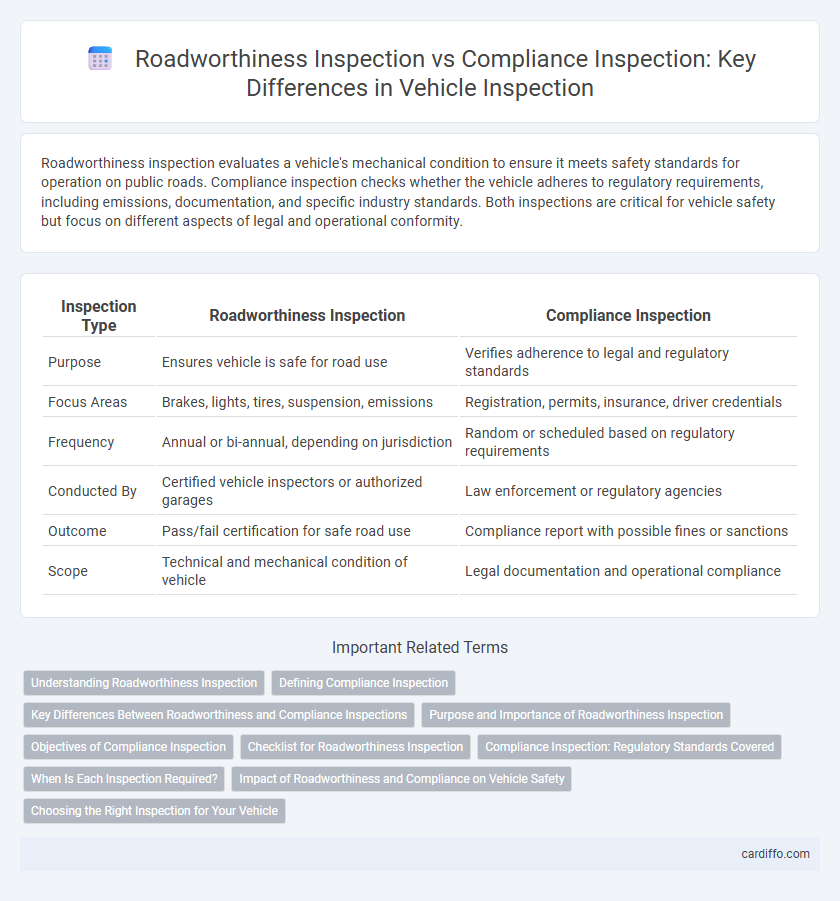Roadworthiness inspection evaluates a vehicle's mechanical condition to ensure it meets safety standards for operation on public roads. Compliance inspection checks whether the vehicle adheres to regulatory requirements, including emissions, documentation, and specific industry standards. Both inspections are critical for vehicle safety but focus on different aspects of legal and operational conformity.
Table of Comparison
| Inspection Type | Roadworthiness Inspection | Compliance Inspection |
|---|---|---|
| Purpose | Ensures vehicle is safe for road use | Verifies adherence to legal and regulatory standards |
| Focus Areas | Brakes, lights, tires, suspension, emissions | Registration, permits, insurance, driver credentials |
| Frequency | Annual or bi-annual, depending on jurisdiction | Random or scheduled based on regulatory requirements |
| Conducted By | Certified vehicle inspectors or authorized garages | Law enforcement or regulatory agencies |
| Outcome | Pass/fail certification for safe road use | Compliance report with possible fines or sanctions |
| Scope | Technical and mechanical condition of vehicle | Legal documentation and operational compliance |
Understanding Roadworthiness Inspection
Roadworthiness inspection ensures a vehicle meets safety and environmental standards by thoroughly checking critical components such as brakes, tires, lights, and emissions systems. This type of inspection verifies that the vehicle is safe to operate on public roads, reducing the risk of accidents and mechanical failures. Unlike compliance inspections that focus on regulatory adherence, roadworthiness inspections prioritize the functional condition and safety performance of the vehicle.
Defining Compliance Inspection
Compliance Inspection ensures vehicles meet regulatory safety and environmental standards by verifying adherence to specific laws and regulations. This inspection evaluates essential components such as emissions, lighting, brakes, and safety equipment to guarantee legal operation on roads. Unlike Roadworthiness Inspection, which assesses overall vehicle condition, Compliance Inspection specifically targets conformity to mandated regulatory requirements.
Key Differences Between Roadworthiness and Compliance Inspections
Roadworthiness inspections primarily evaluate a vehicle's safety features, including brakes, tires, lights, and structural integrity, ensuring the vehicle meets minimum safety standards for operation. Compliance inspections assess adherence to regulatory requirements beyond safety, such as emissions, licensing, permits, and load limits, focusing on legal and operational conformity. Key differences lie in the scope, with roadworthiness centered on mechanical safety and compliance covering broader legal regulations affecting vehicle use.
Purpose and Importance of Roadworthiness Inspection
Roadworthiness Inspection focuses on ensuring vehicles meet safety standards to prevent accidents and maintain operational efficiency, playing a critical role in public safety and environmental protection. This inspection assesses vital components like brakes, tires, lights, and emissions to certify that vehicles are safe for road use. Roadworthiness inspections are crucial for reducing road hazards, minimizing mechanical failures, and ensuring compliance with national traffic regulations.
Objectives of Compliance Inspection
Compliance inspections focus on verifying adherence to regulatory standards and legal requirements for vehicles, ensuring they meet safety, emissions, and operational guidelines. These inspections aim to detect violations that could compromise road safety or environmental quality, reinforcing accountability among vehicle operators. The objective is to maintain a consistent regulatory framework that supports public safety and lawful vehicle use on roads.
Checklist for Roadworthiness Inspection
The Roadworthiness Inspection checklist primarily includes verifying critical vehicle components such as braking systems, tires, lights, steering mechanisms, and exhaust emissions to ensure safe operation on public roads. This inspection emphasizes functionality and safety, confirming that vehicles meet established standards for road use, unlike Compliance Inspections which focus on regulatory adherence like documentation and equipment. Detailed itemization of each element within the Roadworthiness checklist ensures a thorough evaluation aimed at reducing accidents and maintaining optimal vehicle performance.
Compliance Inspection: Regulatory Standards Covered
Compliance Inspection rigorously evaluates vehicles against specific regulatory standards such as emissions, safety features, and equipment requirements to ensure adherence to legal mandates. It covers criteria including brake performance, lighting systems, tire conditions, and exhaust emissions to meet national and regional transportation laws. This inspection type plays a crucial role in maintaining overall road safety and environmental protection by enforcing compliance with current vehicle regulations.
When Is Each Inspection Required?
Roadworthiness inspections are typically required during vehicle registration, after significant repairs, or periodically to ensure safety and mechanical integrity on the road. Compliance inspections occur when verifying adherence to specific regulations, such as emissions standards, safety equipment, or commercial vehicle laws. The timing for each inspection depends on regulatory mandates, vehicle type, and operational use, ensuring both safety and legal conformity.
Impact of Roadworthiness and Compliance on Vehicle Safety
Roadworthiness inspections primarily assess a vehicle's mechanical condition and essential safety features, ensuring it meets legal safety standards to prevent accidents caused by vehicle failure. Compliance inspections focus on verifying adherence to regulatory requirements, such as emissions and documentation, which contribute indirectly to overall road safety by enforcing environmental and operational standards. Together, these inspections enhance vehicle safety by addressing both the physical state of the vehicle and its conformity to safety regulations.
Choosing the Right Inspection for Your Vehicle
Roadworthiness Inspection evaluates a vehicle's safety features, ensuring brakes, tires, lights, and steering meet legal standards to prevent accidents. Compliance Inspection verifies that the vehicle adheres to emissions regulations and manufacturer specifications, confirming environmental and operational standards. Selecting the appropriate inspection depends on your vehicle's purpose--prioritize Roadworthiness Inspection for safety assurance and Compliance Inspection for regulatory adherence.
Roadworthiness Inspection vs Compliance Inspection Infographic

 cardiffo.com
cardiffo.com